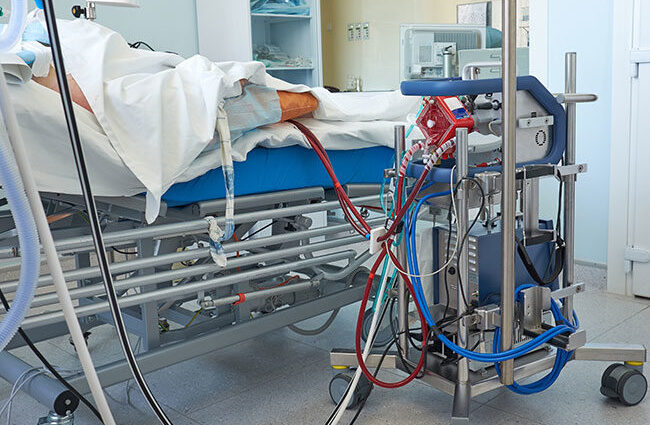Your vital organs like heart and lungs work without a pause to keep you alive. However, sometimes they do not function properly due to several reasons. There comes the need for medical support. Thanks to advanced technology, there is such support available as ECMO in India. Extracorporeal Membrane Oxygenation supplies oxygen to the body when the heart or lungs are not functioning optimally.
What are the advantages of ECMO Treatment in India?
ECMO is used to pump oxygen to body tissues. This process happens outside the body. Warm and oxygenated blood is supplied back to the body tissues. Thus, the ECMO machine is a handy tool and helps the doctors and medical procedures in many ways like:
- ECMO is used to balance oxygen levels in patients with dwindling oxygen.
- It can save a patient undergoing surgery or a transplant.
- It can help save patients suffering from heart or lung failure.
- It is the last resort to the survival of patients with severe lung or heart damage.
- It can help treat babies born with heart or lung-related defects.
- It can help patients survive when they do not respond to any other life support system.
- It can help patients with Acute Respiratory Distress Syndrome due to COVID-19, Pneumonia, etc.
- It can be used as long as it’s required.
- Patients can also be given some mobility exercises under strict medical supervision.
- Its smaller version is convenient to carry in an ambulance or helicopter in an emergency.
How is ECMO better than a ventilator?
When a patient is hospitalized, it sometimes needs respiratory support to survive. Any artificial life support comes with both pros and cons, so do ECMO and ventilators. Let’s understand their comparison in the table below:
| Ventilator | ECMO | |
|---|---|---|
| Similarities | Supports respiration | Supports respiration |
| Differences | The catheter is inserted through the mouth till the windpipe | Tubes are connected with arteries or veins |
| Oxygen is forced into the lungs at regular intervals. | Oxygen is pumped into the blood and carbon dioxide is pumped out of the blood outside the body. | |
| The patient’s lungs may get injured in the process. | The patient’s lungs can rest and heal. | |
| Used only for lungs. | Can function as artificial heart and/or lungs. | |
| The patient’s movement is restricted while on a ventilator. | The patient can be given some mobility exercises under medical supervision. | |
| Less monitoring is required by doctors. | Requires frequent monitoring and a higher level of expertise. | |
| Sometimes it may become more harmful than beneficial as it keeps pushing oxygen to the lungs at equal intervals and amounts. | It is possible to alter oxygen levels efficiently. | |
| Oxygen levels cannot be balanced easily. | Oxygen levels can be balanced as required. | |
| You cannot use it for a long time as it restricts mobility. | You can use it for as long as required as it allows mobility. |
Introduction of ECMO in India
According to an article by NCBI, ECMO was introduced in India in 2001.
- In the beginning, ECMO was used only after heart surgeries. However, from 2008 onwards, ECMO has been frequently used in ICUs.
- The patients facing Acute Respiratory Distress Syndrome (ARDS) or Refractory Cardiogenic Shock were benefited the most by ECMO. For a few years, ECMO in India has been used in the cases of Tracheobronchial surgeries, poisoning, and several transplant surgeries.
- India is constantly progressing on the subject. So far, Indian authors have published three books and several paper presentations.
- The medical practitioners and medical students are continuously updated about ECMO.
The universal pandemic- COVID-19 and ECMO in India
ECMO has helped many people to survive during the second wave of COVID. Those who were struggling with decreasing oxygen levels survived with this therapy. ECMO should be taken as a treatment and not as a cure. However, it has saved those patients who were not responding to any other life support treatment. Thus, ECMO has become more popular post the second wave of COVID. It can be used during the third wave if needed.
What are the bottlenecks faced by ECMO in India?
ECMO may involve risks such as blood clotting while transfusion, chances of stroke, bleeding caused by thinning of blood, infections in the punctured skin, bubble formation in tubes, seizures, malfunctioning of ECMO machines, etc. ECMO is not commonly available across the country due to lack of awareness, less availability of expertise in this subject, and its high cost.
When should ECMO treatment not be given to patients?
ECMO is not recommended when:
- Brain or other vital organs bleed excessively or are severely damaged.
- When the disease or infection is beyond treatment.
What is the scope of ECMO in the treatments in India?
The medical fraternity in India is aware of the ECMO procedure and its benefits. As of now, ISCCM in Bangalore provides ECMO fellowship. Medical professionals are constantly being educated. With the advancement of technology, the ECMO can gain more popularity in India.
Summing-up
ECMO is new hope for treating lung or heart failure or severe respiratory disorders. ECMO treatment has gained popularity, especially post COVID-19 in India. Many shortcomings need to be overcome. However, the new age and technological innovations with ECMO in India can revolutionize medical treatment in India.

